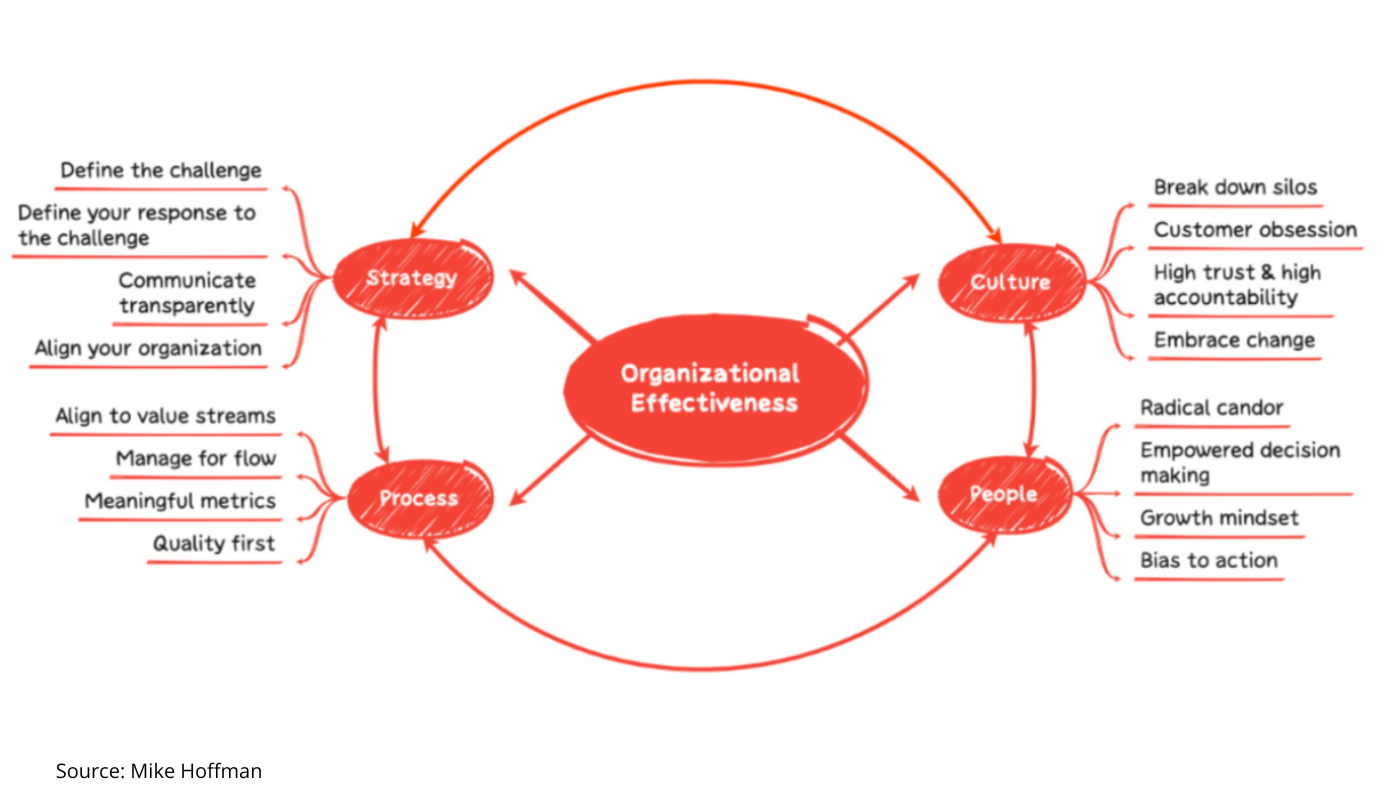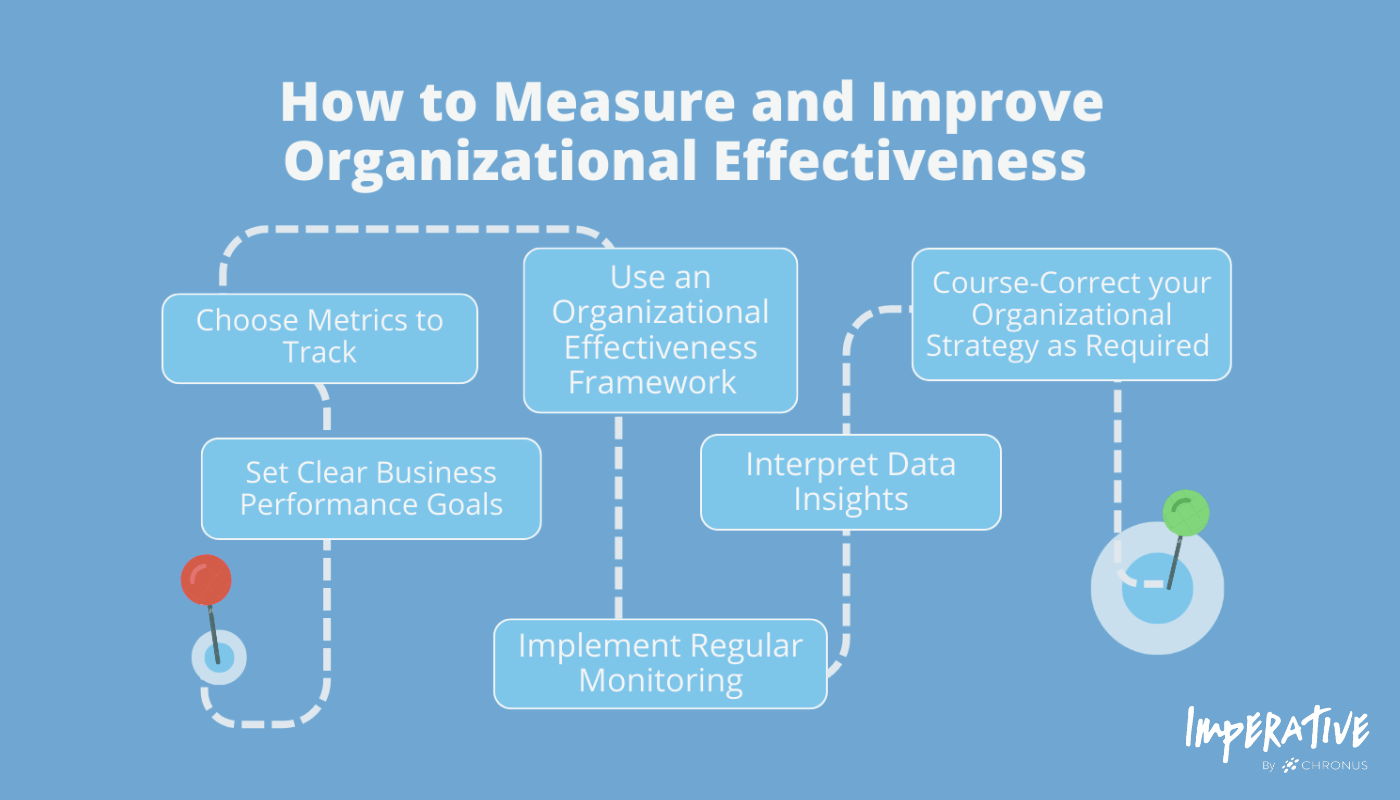Ever wondered if your business is achieving its full potential? Organizational effectiveness is a strategy you can use to measure whether your company is thriving and successfully achieving its goals. In a world where competition is fierce, and innovation is paramount, the ability to measure and enhance organizational effectiveness is not just a priority but a necessity.
What is organizational effectiveness?
The term “organizational effectiveness” is more than just corporate jargon—it’s a critical benchmark for measuring how efficiently a company can achieve its business goals.
For an organization to be effective, it must operate as a cohesive system where all departments, employees, managers and leaders work productively together to drive the business forward. When employees are disengaged, it leads to wasted resources and time, negatively impacting the bottom line.
Explore the five key reasons senior leaders prioritize measuring organizational effectiveness, and learn how top executives and HR leaders can enhance business performance for optimal success.
5 Reasons to Monitor Organizational Effectiveness
Tracking and improving organizational effectiveness isn’t a quick process, but it is worth the effort for the following five reasons:
1. Preventing Workplace Silos
Organizational silos can be defined in the workplace as employees in various departments “not sharing information, goals, tools, priorities or processes with other groups.”
According to a Gallup survey, disengaged employees cost U.S. companies between $450 billion to $550 billion annually in lost productivity. Whether a company is knee-deep in petty feuds or toxic competition, organizational effectiveness can spark a change to help employees work well together and share their knowledge transparently with other key players. Of course, as we’ve welcomed distributed teams and hybrid arrangements into our working culture, distance makes it harder to break silo walls. Starminds “Productivity Drain Research Report” reveals that:
- 41% of people report knowledge silos between departments
- 39% between different ranks and levels of seniority
- 36% between locations
- 32% between remote and office workers
- 29% between teams within the same department.
There’s an opportunity to overcome these silos and unlock tremendous organizational effectiveness by creating an environment where everyone works together, regardless of where they’re based.
2. Aligning Individual Roles with Organizational Strategy
Strategic alignment is about getting everyone—from top-level executives to entry-level employees—on board with your business’s mission. Each team and individual within it must clearly understand their roles and responsibilities and how they contribute to overall organizational success.
Example: Briony is an administrative assistant for a consulting firm whose company mission is to present a consistent and professional image to clients. She receives documents, reports and proposals daily from different teams and ensures they adhere to the company’s formatting and brand messaging guidelines. While seemingly mundane, her role is pivotal in impressing clients. By meticulously standardizing documents, Briony’s role aligns with the overall business strategy and contributes to organizational success.
3. Allocating Resources Effectively
Committing to organizational effectiveness can reveal precisely where your business resources are going. If your teams are wasting resources or spreading themselves too thin, it’s important to adjust your strategy or budget accordingly.
We spoke to Alexandru Contes, Co-Founder of ReviewGrower, who recapped an experience in his early days of managing a startup. The company initiated a quarterly review system to closely examine its projects, teams and finances. The objective was to ensure every penny and minute spent drove the business closer to achieving its goals. Alexandru shared, “One specific instance was when we shifted our marketing budget from general advertising to targeted social media campaigns. The results were eye-opening. We saw a 25% increase in customer engagement while using only 60% of our initial budget. This not only saved costs but also helped us understand where our true potential lay.”
4. Achieving Effective Change Management
Improving organizational effectiveness is crucial for leaders as it empowers them to identify and respond to shifts in the external environment and internal operations. By staying vigilant and adaptive in the face of change, leaders position themselves to remain competitive in the ever-evolving business landscape.
Example: Implementing structured change processes ensures that people leaders can adapt and respond quickly to industry-wide trends such as quiet quitting and employee turnover problems. In this scenario, clear communication with managers and talent acquisition teams will improve the employee experience and streamline onboarding processes so candidates and new joiners enjoy a smooth introduction to the company, and want to remain there.
5. Increasing the Ability to Innovate
From product development to digital innovation, effective organizations aren’t afraid to experiment. The key is for leaders to foster an environment where new ideas and improvements are welcomed, and mistakes are just par for the course. Mentoring programs can be the catalyst to help create a safe, connected space where employees can collaborate with their mentor or mentee to share ideas that improve the workplace for everyone.
Example: Innovation often emerges from unexpected sources, sometimes even from mistakes. Consider the remarkable case of 3M and its iconic product, the Post-It Note. Initially, 3M engineers were working on a project to create a super-strong adhesive for building planes, a task with critical implications.
Their innovative breakthrough came when they inadvertently developed a weaker adhesive that allowed paper to be stuck and peeled away without leaving residue. To some organizations, this discovery may have seemed like a failure. But instead of discarding it, 3M recognized the potential for creating the Post-It Note, a product that has since revolutionized office communication and organization.
What Does Organizational Effectiveness Look Like?
When measuring organizational effectiveness, it can be challenging to visualize whether your organization is already effective or has room for improvement. (Hint: There’s always room for growth!) To support your review, Business Consultant Mike Hoffmann provides a high-level visual overview for assessing how effective your business is.
As you can see, Mike breaks down organizational effectiveness into four main categories: Strategy, Process, Culture and People. However, he also advises, “With so many places to focus, it can be hard to know where to start. To simplify things, I suggest “start where you’re feeling the most pain and then go from there.”
Let’s take a deeper look at each of these areas so you can begin improving your organizational efficiency incrementally.
Strategy
Organizational effectiveness starts with having a clear and comprehensive strategy. This includes understanding the business’s mission, vision and long-term goals. The strategy should outline:
- What success looks like, for example in terms of financial performance, employee motivation, or customer loyalty.
- How the organization sets itself apart from its competitors, known as its unique selling proposition (USP).
- The key performance indicators (KPIs) you’ll use to measure progress towards achieving goals.
- The milestones and time frame associated with strategic goals.
- The roles and responsibilities of team members in executing the strategy.
- The resources required to implement the strategy effectively.
- How the strategy aligns with broader market trends and the customer experience.
Culture
“Positive work cultures always triumph over pressurized, fear-based ones. When organizations develop a positive, virtuous culture, they achieve significantly higher levels of organizational effectiveness, including financial performance, customer satisfaction, productivity and employee engagement,” says Katy McIntyre, Director of People & Culture at Hammonds Furniture. And we agree.
When you create an organizational culture of respect, collaboration and growth, your workers will strive to perform better and progress in their careers within the organization. Operations Manager Taimur Khan explains how AED TRAINING introduced an organizational effectiveness gauge known as the “Employee Mobility Index” to better understand the positive impact of the company’s growth culture. He told us,
“I distinctly recall a few months ago, tracking a new hire. She started in a beginner’s role but, due to our training and mentorship, quickly climbed to an intermediate position within just six months.
This rapid progression wasn’t just a win for the new employee; it reflected how effectively our company fosters growth and cultivates talent. By monitoring such transitions, we get real-time insight into our organization’s health.”
Processes
Whether you’re tracking mobility, performance management or any other internal process, they must all run like clockwork for an organization to be effective. To optimize these business processes, leaders increasingly turn to automation to streamline efficient operations and maximize resource allocation. The impact of digitization has eliminated manual and repetitive tasks to free up time for employees to focus on higher-value projects, fostering innovation and growth.
Automation’s impact spans a wide range of activities, including product development, quality control, customer support, inventory management, marketing and more. It makes these processes more accurate and responsive, contributing to improved overall performance. The best part: Efficient processes often translate directly into financial return, which you can track using financial metrics like:
- ROI (return on investment): By comparing the gains achieved (such as cost savings, increased efficiency and reduced errors) against the costs incurred for implementing automation, businesses can determine if their investments are yielding a positive return. A high ROI indicates that the organization is effectively using its resources to achieve improved outcomes.
- Profit margins: When operational costs are reduced through process improvements, profit margins tend to improve. Higher profit margins demonstrate that the organization is effectively managing its costs and generating more revenue relative to expenses, which is a key indicator of organizational effectiveness.
- Cost reductions: Streamlined processes lead to lower labor costs, especially in tasks prone to human error or inefficiency. These cost reductions directly contribute to overall financial health and indicate how effective an organization is in managing its operations efficiently.
However, not all internal processes are automated or measured directly by cost. In the case of Training Director Derek Bruce, his company Skills Training Group measures organizational effectiveness by improving its quality of decisions, at speed.
He shares, “I recall a specific instance when we introduced a new training module. Within a mere 24 hours, our team deliberated on its merits, gathered feedback, made necessary tweaks, and rolled it out. The rapid yet thoughtful decision-making exemplified our commitment to swift action while maintaining quality. We believe that time saved in decisive action translates directly into better results for our clients.”
People
People are the heart and soul of any business. We all know that engaged and satisfied employees result in increased productivity, innovation and overall success. But it’s not always straightforward to monitor or improve your people’s spirit.
Metrics such as the following are a great way to take the temperature of your organization and understand the sentiment across all department and leadership levels:
- Pulse surveys: Frequent, short questionnaires capture current feelings and perceptions of your workforce. These quick surveys provide a snapshot of employee morale, identify concerns and offer actionable insights for improvement. Top tip: Use the same questions each time enabling you to measure the difference in responses.
- Engagement and satisfaction scores: Engagement surveys are more comprehensive assessments of employee perspectives, commitment and organizational satisfaction. These surveys typically include a range of questions that delve into various aspects of work, such as job role, relationship with supervisors, work-life balance and growth opportunities.
- Employer net promoter scores (eNPS): Similar to the Net Promoter Score used to measure customer loyalty, the Employer Net Promoter Score (eNPS) gauges employee loyalty and advocacy. By asking whether employees would recommend their workplace to others, organizations can assess overall employee satisfaction and identify areas for improvement.
- Mentoring and ERG Software: Utilizing Chronus mentoring and ERG (Employee Resource Group) software provides data-driven insights into employee engagement, retention and productivity. It tracks participation and development, helping organizations align these programs with business goals.
Beyond tracking these metrics, Co-Owner Lucas Riphagen describes a unique way that TriActiveUSA has measured its people function using the “Employee Network Analysis” method. He told us.
“A few months ago, I noticed a slight lag in our communications chain, so we mapped out the interactions between team members to identify bottlenecks. This helped us spot areas where information was getting held up and where certain employees were overloaded with tasks. It was enlightening to see the web of interactions, and by strengthening key links, we dramatically improved our workflow and team synergy.”
How to Measure and Improve Organizational Effectiveness
Regardless of which operational area you’re focused on, follow these steps to proactively boost your entire organization’s performance and achieve lasting success:
1. Set Clear Business Performance Goals
Drive organizational effectiveness by establishing clear and actionable goals, which you can achieve by using the SMART framework to create Specific, Measurable, Achievable, Relevant and Time-bound goals.
Example: Imagine your organizational goal is to improve customer satisfaction. A SMART goal would be: “Increase customer satisfaction ratings by 15% within the next six months through improved responsiveness and personalized support.”
2. Choose Metrics to Track
By tracking the right metrics, you’ll clearly understand where your efforts are yielding results and where you need to make adjustments. Selecting the right metrics depends on the goals you’ve outlined above. Remember also that too much data can be overkill, so choose two to five metrics to keep the focus area tight. Select metrics that directly align with your strategic objectives and provide quantifiable insights into your progress. Taking advantage of Chronus software is a great way to help track, measure and scale your initiatives to improve employee engagement.
3. Use an Organizational Effectiveness Framework
Several established frameworks can guide your efforts if you’re struggling to decide what to measure. Here are a few options:
- Balanced scorecard
The balanced scorecard framework focuses on four key perspectives: financial, customer, internal processes, learning and growth. It takes a holistic approach to reviewing an organization’s performance and helps align strategies with common goals. - McKinsey’s 7-S framework
The 7-S model identifies 7 x interconnected factors contributing to organizational effectiveness: strategy, structure, systems, shared values, style, staff and skills. It emphasizes the interplay between these elements and how you must align them for success. - Weisbord’s Six-box model
The six-box model identifies six measurable impacts of an organization’s effectiveness: purpose, organizational structure, relationships, rewards, leadership development and helpful mechanisms. The model also provides a framework for diagnosing and addressing any issues.
4. Implement Regular Monitoring
Regular monitoring of your chosen metrics ensures that you stay on track and make informed decisions. Start by taking a real-time benchmarking snapshot using your chosen metrics, then remeasure at intervals that make the most sense to your organization. For example, when measuring the effectiveness of your mentoring program, you might choose monthly, quarterly, biannual, or annual measurements.
5. Interpret Data Insights
Only once the number-crunching is complete can the hard work begin. Acting on data insights requires a deep understanding of the context surrounding the stats. Analyze trends, patterns and variations in the data to identify areas of improvement and potential challenges for your organization.
Data-driven insights empower you to make informed adjustments to your strategies. But, this step will be naturally easier if you can lean on in-house analytical skills or outsource to a relevant company that can make sense of the data on your behalf.
6. Course-Correct your Organizational Strategy as Required
Organizational effectiveness is an ongoing journey. Regularly assess your progress and be prepared to adjust your strategies based on data-driven insights, presented in pretty reports. Flexibility and adaptability are key to addressing evolving challenges and capitalizing on new opportunities.
Build Organizational Effectiveness with Chronus
With Chronus, disconnected workplace cultures are never an option. Our mentoring and Employee Resource Group (ERG) software helps your organization thrive by keeping employees connected and engaged. By focusing on strategy, culture, people and processes, Chronus drives continuous improvement, boosting performance and productivity.
Additionally, our platform simplifies the automation process, making it easy for employees to stay connected. Chronus helps you turn the idea of organizational effectiveness into reality by creating an environment of open communication, collaboration and growth within your team.



